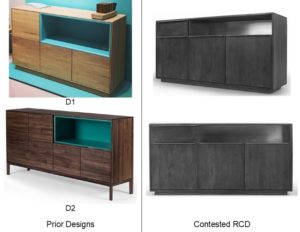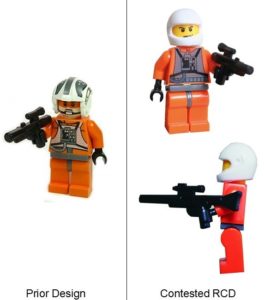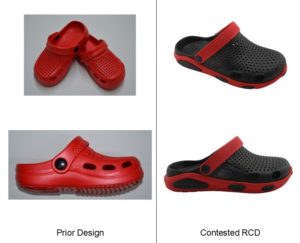25/08/2020
April to June 2020
This blog covers invalidity decisions issued by the EUIPO during the second quarter of 2020, from 1 April 2020 to 30 June 2020. Our previous blog covering the decisions issued during the first quarter of 2020 can be found here.
Registered Community designs (RCDs) protect the shape and appearance of new products across the whole of the EU. Since national court decisions on RCDs are rare, decisions by the EUIPO’s Invalidity Division help us to understand how the validity of an RCD is interpreted.
Summary
There were 95 invalidity decisions issued between 1 April 2020 and 30 June 2020. 70 invalidity actions (74%) were successful, meaning that the contested registered Community design was invalidated by the Invalidity Division. 25 invalidity actions (26%) were unsuccessful, meaning that the application for a declaration of invalidity was rejected and the RCD was maintained as granted.
Some of the invalidity decisions issued during the period of April to June 2020 are highlighted below.
A valid registered Community design must be novel and have individual character. An RCD is deemed to lack novelty over a prior design if their features differ only in immaterial details. An RCD is deemed to lack individual character over a prior design if the two designs produce the same overall impression on the informed user.
1. Sourceable Limited (Applicant) vs.
Made.com Design Limited (RCD Owner)
Invalidity No. 105799
This invalidity decision concerns registered Community design no. 003834209-0004, which was filed on 31 March 2017 and is in the class of “Storage Furniture”.
The EUIPO’s Invalidity Division rejected the application for a declaration of invalidity because the contested design “clearly departs” from the prior art.

Figure 1
The registered Community design owner is a well-known UK company that designs and sells homeware and furniture online. The invalidity applicant argued that the contested RCD lacks individual character over storage furniture disclosed on websites and social media.
In an invalidity action, the onus is on the invalidity applicant to prove disclosure of the earlier design(s). To this end, the evidence supplied by the invalidity applicant comprised of website screenshots and screenshots of posts from Twitter and Instagram. The website screenshots were undated and so the Invalidity Division decided that these do not prove disclosure of the prior design. However, the social media posts were dated and the Invalidity Division stated that there is no evidence that their content was not publicly available on the dates mentioned. Although the two social media posts (D1 and D2) each only include a single image of an earlier design, the Invalidity Division deemed them to be suitable because “the images are of good quality and show sufficient parts of the prior designs to perform a comparison between the earlier designs and the contested design”.
The next step was to consider individual character. Does the overall impression produced by the contested registered Community design differ from the overall impression produced by either of the prior designs? The Invalidity Division decided that a designer has a lot of freedom when developing a sideboard or storage furniture. Although there are restrictions that the product must contain a storage space and usually contains doors and/or drawers, there are “infinite possibilities for altering the form of the product’s elements, their positioning and also the shape, surface texture colour and general appearance of the product”. Accordingly, only minor differences between the contested RCD and the prior designs would not be deemed enough to produce a different overall impression.
The Invalidity Division agreed with the invalidity applicant that there are a number similarities between the prior designs and the contested registered Community design. For example: D1, D2 and the contested RCD all have a smooth and flat top, sides and base; there is an absence of surface decoration; and there is an absence of prominent handles or similar features. When considering D1, the Invalidity Division noted that D1 and the contested RCD have three lower cupboards with doors of equal size; one upper cupboard on the left hand side with a void at the upper right hand side that is the equivalent size and space of two cupboards; and no visible legs. However, the Invalidity Division also noted that there are striking differences between the proportions of the storage spaces of the contested RCD and D1. In the contested RCD: “the upper level takes up less than a third of the height of the main body of the sideboard, whereas in design D1, the upper and lower level have the same height”, and the sections “all have rectangular shapes, with landscape orientation in the upper level and portrait orientation in the lower level. In contrast, in the prior design D1, all sections, except the open part, are square”. The Invalidity Division then stated that there are even greater differences between the contested RCD and D2 because D2 has two additional storage compartments to the left, and D2 has four clearly visible legs.
The differences between the contested registered Community design and the two prior art designs were considered to be significant such that they lead to a clearly different overall impression on the informed user. Accordingly, the Invalidity Division held that the contested RCD has individual character and therefore rejected the invalidity action.
2. LEGO Juris A/S (Applicant) vs.
MAR 2000 OOD (RCD Owner)
Invalidity No. 107919
This invalidity decision concerns registered Community design no. 003476118-0002, which was filed on 16 December 2016 and is in the class of “Toy Figures”.
The EUIPO’s Invalidity Division declared that the contested registered Community design is invalid because the contested design does not produce a different overall impression from that of the prior design.

Figure 2
The invalidity applicant is an internationally known toy company. The invalidity applicant argued that the contested registered Community design is a copy of a Luke Skywalker figure that they have been selling since 1999, and that any differences between the contested RCD and these prior designs were negligible.
In support of their arguments, the invalidity applicant submitted printouts from third party websites showing images of various Luke Skywalker figures that they have sold since 1999. The invalidity applicant also submitted a printout of an Amazon.de listing. In response, the registered Community design owner disputed the disclosure of the printouts, arguing, amongst other things, that: 1) the Amazon printout had a long URL which did not permit it to be searched for so it couldn’t be found during the normal course of business; and 2) the information in the evidence could have been altered.
The Invalidity Division stated that it is established case law that an Amazon product listing is sufficient to prove that a product has been offered for sale and that the listing submitted by the invalidity applicant predates the filing date of the registered Community design. The Invalidity Division also noted that the RCD owner did not demonstrate in what respect the evidence has been altered and that it is established case law that mere allegations are not sufficient to doubt the veracity of the evidence. The Invalidity Division accepted that the evidence submitted by the invalidity applicant was sufficient to prove disclosure of at least one of the prior designs. For the sake of procedural economy, this one prior design was used in assessing individual character of the contested RCD.
The Invalidity Division noted that the fact the contested registered Community design and the prior design are composed of parts of the human body “will not play a substantial role” in assessing individual character. The Invalidity Division then turned to all other visual features, including “the particular shape of the body and garments, and the decoration or colour scheme” and said “It is noticeable that in all these aspects the designs show more similarities than differences. The body, legs and arms of both figures have the same shapes and proportions, and the colour scheme – the combination of black and grey on an orange background. Both figures hold in one of their hands a gun resembling a laser gun, identically shaped”. The most noticeable differences were deemed to be in the shape and decoration of the helmets of the figures in the designs. However, the Invalidity Division asserted that “the designs’ common characteristics as described above are clearly noticeable and of greater significance than the differences in the decoration of the garments, the colours of the faces and differently shaped helmets”. As a result, the Invalidity Division found that both designs produce the same overall impression and so the contested RCD lacks individual character over the prior design and is therefore invalid.
3. Crocs, Inc. (Applicant) vs.
Jia Wei (RCD Owner)
Invalidity No. 109223
This invalidity decision concerns registered Community design no. 006427399-0002, which was filed on 6 May 2019 and is in the class of “Shoes”.
The EUIPO’s Invalidity Division declared that the contested registered Community design is invalid because it does not have individual character over the prior design.

Figure 3
The invalidity applicant is the American company that manufactures and distributes ‘Crocs’ foam clog shoes. The invalidity applicant argued that the contested registered Community design is identical or lacks individual character over three of their earlier registered Community designs. For disclosure of the prior designs, the Invalidity Division stated that “Publication of an earlier design in the Office bulletin constitutes disclosure”. This is one reason why registered Community designs are a very good option for prior art when filing an invalidity action. As usual, for the sake of procedural economy, the Invalidity Division started by comparing the contested registered Community design with the first of the prior designs.
The Invalidity Division agreed with the invalidity applicant that there are many similarities between the contested registered Community design and the first prior design. For example: both designs have identical overall clog shapes; both designs have very similar hole patterns on the front of the clog; and both designs have a very similar heel strap which is attached using a flat button. However, the Invalidity Division also noted some differences between the two designs: the prior design has a bright red colour whilst the contested design is black with a red strap; the contested design has three black sole reinforcements along its side, which are absent in the prior design; and the pattern on the soles of the shoes are different. These differences were not considered to be immaterial and so the Invalidity Division found that the contested RCD is new over the prior design.
The Invalidity Division then went on to consider individual character. The Invalidity Division held that although the basic shape of a clog is a given, “the degree of freedom of a designer as regards the strap mechanism and the surface pattern is not limited”. This means that the designer has broad freedom in developing a shoe design and so only minor differences between the prior design and the contested RCD would be insufficient to produce a different overall impression on the informed user. The Invalidity Division then stated that “the differences between the designs… are considerably less striking than the overall impression created by their common features” and that the contested RCD “almost reproduces features of the prior design that are arbitrary and not subject to any technical necessity obliging a designer to adopt a particular shape and size”. In view of this, the Invalidity Division declared that the contested RCD is invalid because it lacks individual character over the prior shoe design.
This blog covers invalidity decisions issued by the EUIPO during the second quarter of 2020, from 1 April 2020 to 30 June 2020. Our next blog, which will cover invalidity decisions issued during the third quarter of 2020, will be published in October 2020.
If you would like to discuss how registered designs can help to stop third party knockoffs, how to invalidate a design registration may be being used against you, or for more information about registered designs and other forms of intellectual property protection, please contact us.
This article is for general information only. Its content is not a statement of the law on any subject and does not constitute advice. Please contact Reddie & Grose LLP for advice before taking any action in reliance on it.


